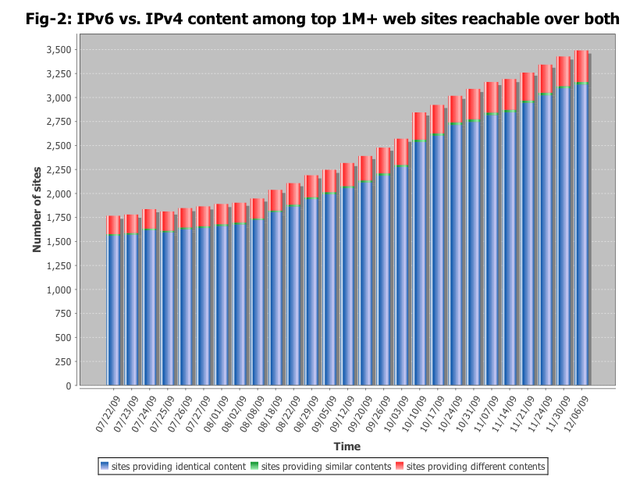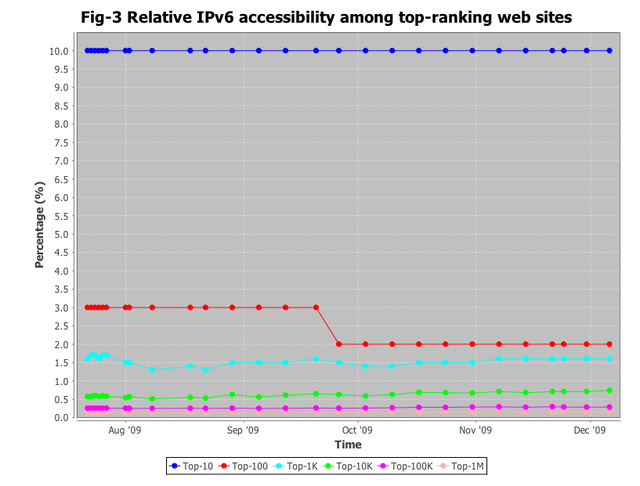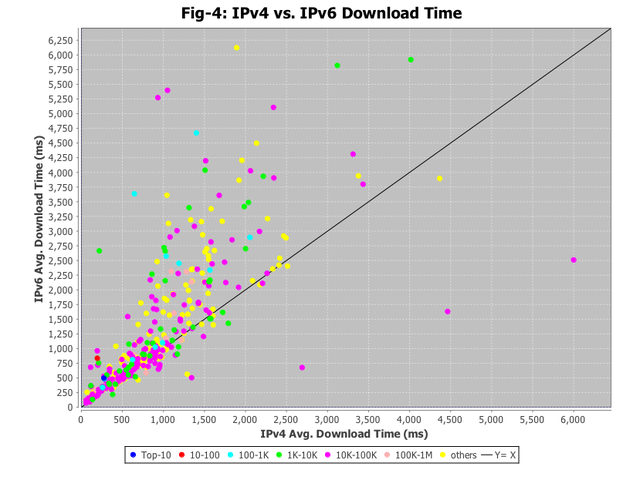During IETF 74, I sat down with Alain Durand to ask him to explain the type of IPv6 measurements he is doing at Comcast ( http://ipv6monitor.comcast.net ) together with the University of Pennsylvania ( http://mnlab-ipv6.seas.upenn.edu ).
Alain: Before we start I would like to stress that this is a long-term study with the aim to see how the amount of IPv6 content is increasing over time. This project is done in collaboration with Roch Guerin of the University of Pennsylvania.
RIPE Labs: How many sites do you see as being accessible through both IPv4 and IPv6?
Alain: For every scan we measured the percentage of sites from the top one million Alexa ranked web sites that are accessible via both IPv4 and IPv6. There is a link to the raw data on the bottom of each page [see Figure-1 below].

RIPE Labs: What is a scan?
Alain: Every night the program is downloading the top one million from the Alexa database. Then it is crawling the Internet to find AAAA records for all the sites listed there. All those web sites are then probed.
RIPE Labs: Do you expect to see a big increase now Windows 7 has launched?
Alain: This is completely unrelated. We measure presence of IPv6 content, not the usage of that content.
RIPE Labs: Are you planning to take measurements from other locations in the network?
Alain: There are currently two locations: one at University of Pennsylvania and one at Comcast. The software will be available for others to do the same measurements from their networks. A number of organisations showed interest already (including the RIPE NCC).
RIPE Labs: Do you see different content provided through IPv4 and IPv6?
Alain: It shows that most sites provide the same or very similar content on their IPv4 and IPv6 sites. Only a small number of sites provide different content. [see Figure-2 below].

RIPE Labs: How did you determine if the content provided was identical, similar or different?
Alain: We used the following rule to compare content fetched via IPv4 and IPv6 from a website: if the difference in terms of the size of the corresponding web pages is within 6% of the bigger one, they are identical; if that number is within 20%, they are similar; and for all other cases, they are different.
RIPE Labs: Can you please explain what you measured in Figure-3 ? And what if the top 10 increases to 100%? What will the graph look like then?

Alain: The most popular content seems to be adopting IPv6 earlier than less popular content. We will have to see if this trend continues. In any case we will have to deal with the long tail of content that will take more time to transition to IPv6. So, the transition mechanisms to maintain IPv4 service after the exhaustion of available IPv4 address space will have to be in place for a long time.
RIPE Labs: When measuring the sites, did you observe a difference in download time, i.e. was it faster or slower to download content via IPv6?
Alain: We produced a graph [see Figure-4 below] that shows, as a 'frame', the performance comparison of retrieving content via IPv4 with that via IPv6 for all sites providing identical content via both for each scan (More technical details: A 'frame' for a scan is generated by plotting a dot at (x, y) for each site providing identical content via both IPv4 and IPv6 in the scan, where x and y stand for average download times, in milliseconds, obtained by repeatedly downloading the site's web page via IPv4 and IPv6 until the 95% confidence interval is less than some given threshold, respectively. Currently, the threshold value is set to be 10% of the average. The colour of a dot indicates the ranking of that dot's corresponding site. All the frames can be traversed by the two buttons and the drop-down box below the figure).

RIPE Labs: Can you please explain what we are seeing on Figure-4. The dots on the left represent sites for which the IPv6 downloads are slower than IPv4. Why is that?
Alain: First we see sites that are faster in IPv6 than IPv4. That is surprising. The ones that take longer in IPv6 than in IPv4 are the ones that are interesting to study and to find out what is causing that. There could be a number of reasons: it could be network-related. It could be because of the content delivery network, or a load balancer with different properties in IPv4 and IPv6. Maybe IPv4 and IPv6 servers have different characteristics. There are many possible reasons and by working directly with those sites that show those delays, we hope to find out what the most common causes are. That will be the next step of the project. We are planning to make this information available so that others can use the data to do similar analysis in their own networks.
RIPE Labs: So, does this mean that at the moment the download time for IPv6 is still higher for most sites?
Alain: Yes, that is true. That is what we expected, because we are in the early days. Over time, we will have to see if those dots are coming closer to the black line. That trend is more important than the actual location of one dot right now.
RIPE Labs: What is the difference between Figure-4 and Figure-5?
Alain: Figure-5 shows the same as Figure-4, but it is normalised. We divided the download time by the size of the page. However, so far we have not really seen much difference in the results.






Comments 0
The comments section is closed for articles published more than a year ago. If you'd like to inform us of any issues, please contact us.